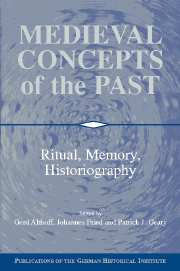Book contents
- Frontmatter
- Introduction
- 1 Authority and Legitimation of Royal Policy and Action: The Case of Henry II
- 2 King Henry II of Germany: Royal Self-Representation and Historical Memory
- 3 The Variability of Rituals in the Middle Ages
- 4 Rebels and Rituals: From Demonstrations of Enmity to Criminal Justice
- 5 Oblivion Between Orality and Textuality in the Tenth Century
- 6 Text and Ritual in Ninth-Century Political Culture: Rome, 864
- 7 The Concept of Time in the Historiography of the Eleventh and Twelfth Centuries
- 8 Constructing the Past by Means of the Present: Historiographical Foundations of Medieval Institutions, Dynasties, Peoples, and Communities
- 9 Topographies of Memory: Center and Periphery in High Medieval France
- 10 Challenging the Culture of Memoria: Dead Men, Oblivion, and the “Faithless Widow” in the Middle Ages
- 11 Artistic and Literary Representations of Family Consciousness
- 12 The Strange Pilgrimage of Odo of Deuil
- 13 The Rhineland Massacres of Jews in the First Crusade: Memories Medieval and Modern
- 14 The Martyr, the Tomb, and the Matron: Constructing the (Masculine) “Past” as a Female Power Base
- Index
1 - Authority and Legitimation of Royal Policy and Action: The Case of Henry II
Published online by Cambridge University Press: 05 January 2013
- Frontmatter
- Introduction
- 1 Authority and Legitimation of Royal Policy and Action: The Case of Henry II
- 2 King Henry II of Germany: Royal Self-Representation and Historical Memory
- 3 The Variability of Rituals in the Middle Ages
- 4 Rebels and Rituals: From Demonstrations of Enmity to Criminal Justice
- 5 Oblivion Between Orality and Textuality in the Tenth Century
- 6 Text and Ritual in Ninth-Century Political Culture: Rome, 864
- 7 The Concept of Time in the Historiography of the Eleventh and Twelfth Centuries
- 8 Constructing the Past by Means of the Present: Historiographical Foundations of Medieval Institutions, Dynasties, Peoples, and Communities
- 9 Topographies of Memory: Center and Periphery in High Medieval France
- 10 Challenging the Culture of Memoria: Dead Men, Oblivion, and the “Faithless Widow” in the Middle Ages
- 11 Artistic and Literary Representations of Family Consciousness
- 12 The Strange Pilgrimage of Odo of Deuil
- 13 The Rhineland Massacres of Jews in the First Crusade: Memories Medieval and Modern
- 14 The Martyr, the Tomb, and the Matron: Constructing the (Masculine) “Past” as a Female Power Base
- Index
Summary
Almost a thousand years ago, in November 1007, King Henry II found himself in a strange situation. The archbishops and bishops of the realm had gathered at a synod in Frankfurt, and the king is said to have told them that he wanted to establish a new bishopric in Bamberg. In this way, the king said, he wished to offer nearly all his possessions and the estates that he would acquire in the future to the eternal father. Even so, the king had to reckon with difficulties. The bishop of Würzburg - also named Henry - who would have to give up portions of his diocese for this plan, had sent his chaplain Berengar to Frankfurt in order to lodge the strongest protest against the planned episcopal foundation. No diocese could be altered against the will of the affected bishop in his absence, argued Berengar. Now the synod was to decide the matter, and it became clear that the king's chances of success were not good. Yet on every occasion when a legal decision went against the king, Henry II, according to the chronicler Thietmar of Merseburg, threw himself onto the ground in a gesture of humility (humiliatur). And in fact the bishops were unable to ignore this gesture of entreaty and humility; at its close, the synod agreed to the foundation of Bamberg.
The story admittedly is not unknown, and it is commonly used as evidence for how sly and calculating this king was in his dealings with bishops. Medieval kingship was a game of tricks, or so it may almost appear to us.
- Type
- Chapter
- Information
- Medieval Concepts of the PastRitual, Memory, Historiography, pp. 19 - 38Publisher: Cambridge University PressPrint publication year: 2002
- 2
- Cited by



